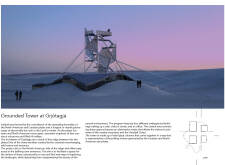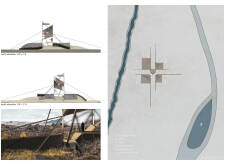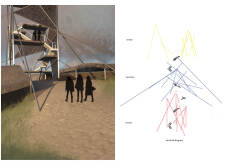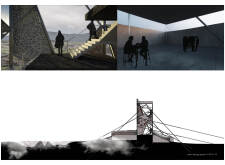5 key facts about this project
Design and Functionality
The Grounded Tower’s architectural design is centered around a clear conceptual framework that expresses the dynamic geological forces at play in the region. The use of steel pipe columns provides structural stability while creating a lightweight appearance that evokes the rugged terrain. The multi-functional spaces within the tower are deliberately designed to enhance visitor flow, accommodating a range of activities from rest and refreshment to learning and observation.
The layered facades composed of glass and composite materials allow natural light to filter through while offering expansive views of the surrounding landscape. This feature serves not only an aesthetic function but also contributes to energy efficiency by utilizing sunlight during daylight hours. The integration of concrete in the design ensures a strong foundation for the tower, reinforcing its connection to the earth, which is vital given the geological context of the site.
Geological Harmony
What sets the Grounded Tower apart is its unique approach to integrating architecture with the geological features of Grjótagját. Instead of imposing a structure upon the landscape, the design flows with the natural topography, allowing for an unobtrusive presence. The project emphasizes the connection between humans and nature, inviting visitors to explore the thermal features of the area while providing a respectful architectural statement.
The architectural design also includes a central observation area, strategically located to optimize views of the Hverfjall Crater and surrounding mountains. This intentional placement encourages contemplation and appreciation of the natural beauty, aligning with the project's goal to facilitate a deeper connection with the environmental context.
Crafting an Experience
The experience within the Grounded Tower is designed to enhance the visitor journey, fostering a sense of exploration and interaction. Key spaces, such as the café and visitor center, are framed to encourage communal activities, while quiet observation spots cater to those seeking solitude. This versatility showcases how architectural design can address diverse user needs while harmonizing with its setting.
To further understand the nuances of this architectural project, readers are encouraged to explore the architectural plans, sections, and designs. These resources provide deeper insights into the design strategies and outcomes achieved in the construction of the Grounded Tower at Grjótagjá, illustrating the effectiveness of merging architectural concepts with environmental considerations.


























